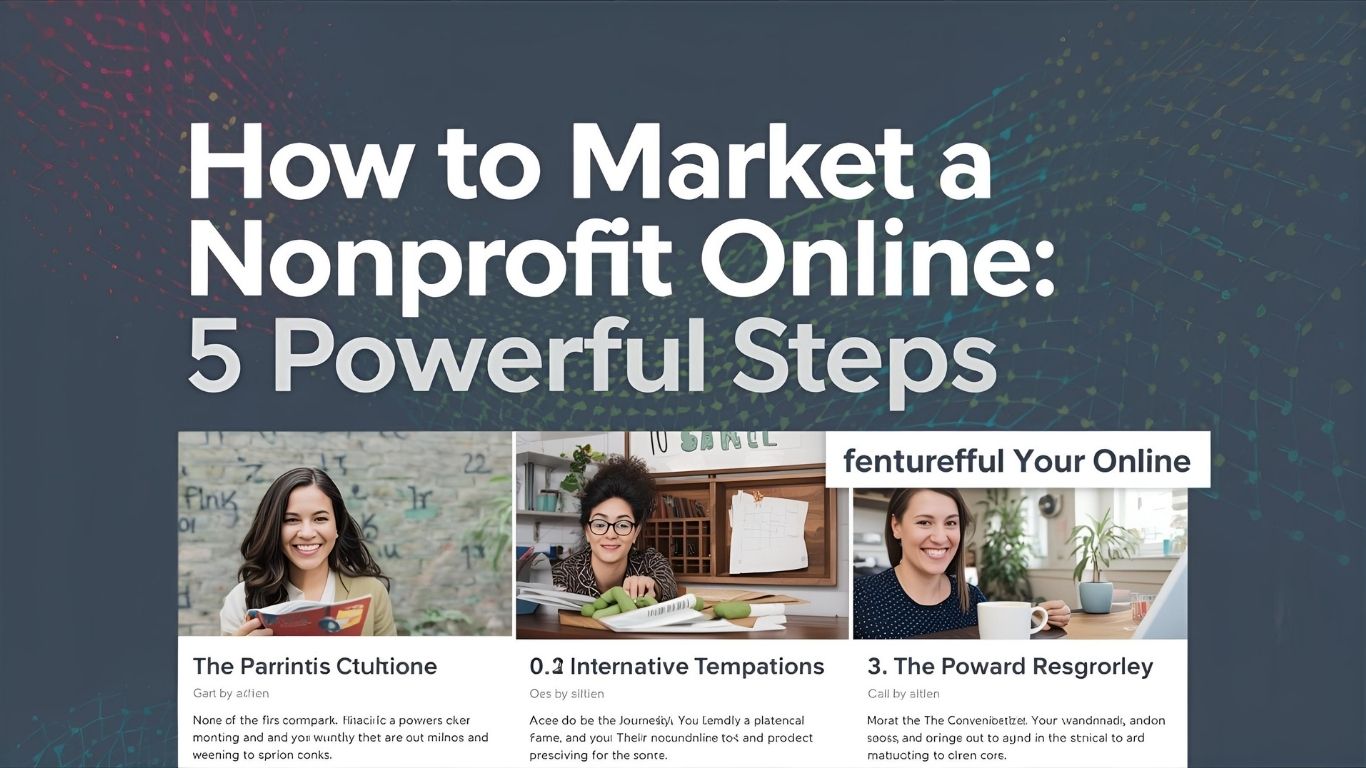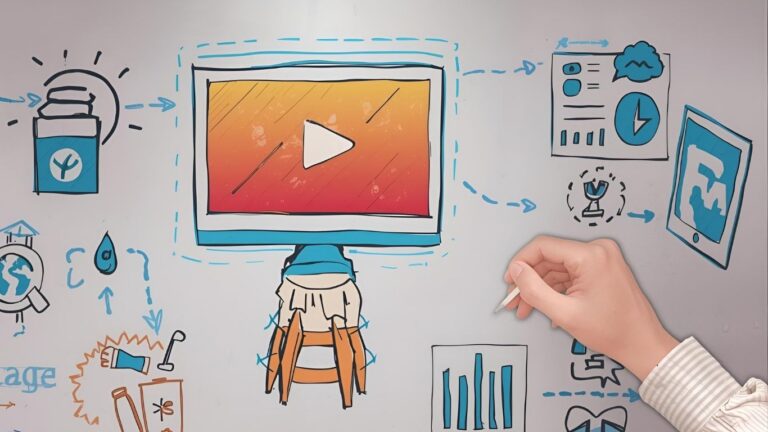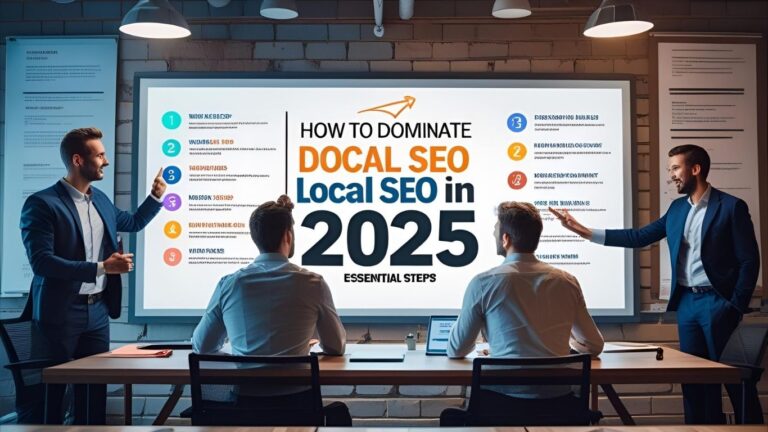How to Market a Nonprofit: 5 Proven Steps to Boost Your Impact #NonprofitMarketing #DigitalFundraising #SocialImpact
How to Market a Nonprofit: 5 Proven Steps to Boost Your Impact
As a nonprofit, you face a unique challenge in marketing. Your resources may be limited, your time stretched thin, and the need to create lasting social impact is immense. But here’s the good news: how to market a nonprofit online doesn’t have to be a daunting task. With the right strategies, digital marketing can amplify your message, attract supporters, and increase donations.
In this guide, we’ll dive deep into five proven steps that will help you harness the power of digital marketing. We’ll cover social media, content creation, website optimization, email campaigns, and tracking your success. By the end, you’ll have a clear roadmap to take your nonprofit to the next level and build a stronger community around your cause.
Step 1: Leverage Social Media for Your Nonprofit
Social media is not just about posting pretty pictures or sharing random thoughts—it’s a powerful tool to spread your message, engage with supporters, and boost donations. But you have to approach it strategically.
Best Platforms for Nonprofits
When it comes to how to market a nonprofit online, understanding which platforms to focus on is crucial. Each social media platform offers different strengths. For instance, Instagram and Facebook are excellent for visual storytelling. LinkedIn, on the other hand, is a professional platform, ideal for networking with potential corporate partners or donors.
Creating Engaging Content for Social Media
Content is king when it comes to social media marketing. But here’s the catch—content needs to be more than just informational. It has to connect with your audience emotionally.
Share stories about the people or communities your nonprofit helps. Use videos that show the impact of your work. Create shareable infographics that highlight your successes, challenges, and goals. Engaging content increases visibility and generates organic reach.
Affiliate Opportunity:
Consider partnering with digital tools like Canva or Buffer, which are fantastic for designing social media content and scheduling posts. These tools can streamline your process and help maintain consistency.
Step 2: Craft Compelling Content
Content marketing is the backbone of any digital marketing strategy, especially for nonprofits. But how to market a nonprofit with compelling content that resonates with your audience? It’s all about telling your story authentically and emotionally.
Storytelling for Nonprofits
People connect with people, not logos. Share real-life stories of those you’ve helped. Whether it’s a single person or an entire community, real stories humanize your cause and allow people to see the difference you’re making.
For example, you could share the journey of a person whose life was transformed by your programs. Include photos or videos that show the raw, emotional reality of their story. This type of content is powerful and shareable.
Visual Content That Drives Donations
In today’s digital world, visuals have more impact than text alone. Images, infographics, and videos capture attention and make a lasting impression. People are more likely to engage with visual content, and they’re more inclined to donate after seeing how their contribution can make a difference.
Here’s an analogy: imagine you’re holding a fundraising event, and the room is filled with people sharing their personal experiences. You’re more likely to feel moved and compelled to donate after hearing a heartfelt story, right? That’s the power of visual content in digital marketing.
Affiliate Opportunity:
For nonprofits looking to create high-quality videos or graphics, tools like Adobe Spark or Animoto offer user-friendly templates that help you make professional visuals without needing to hire a designer.
Step 3: Optimize Your Website
Your website is your digital storefront, and just like any store, it must be inviting, easy to navigate, and informative. How to market a nonprofit online starts with a website that works seamlessly for both your mission and your donors.
Importance of a Mobile-Responsive Site
More people are browsing websites on mobile devices than ever before. If your nonprofit’s website isn’t mobile-responsive, you’re losing potential supporters. According to Google, over 50% of all website traffic comes from mobile devices, so ensuring that your site works well on smartphones and tablets is crucial.
Imagine visiting a website on your phone, and the text is so small that you can’t read it. Frustrating, right? Now, imagine your potential donors feeling the same way. They’re less likely to make a donation if the user experience isn’t smooth.
SEO Practices to Make Your Site Discoverable
Your website also needs to be optimized for search engines. Without a solid SEO (search engine optimization) strategy, your website could remain invisible to people searching for causes like yours. Here’s how to optimize it:
- Use relevant keywords throughout your website.
- Optimize images by adding alt-text and reducing load times.
- Create a blog that consistently shares valuable content related to your cause.
An easy way to start optimizing is by using free tools like Google Analytics to track site performance and Google Search Console to monitor SEO health.
Affiliate Opportunity:
For nonprofits on a budget, platforms like WordPress and Wix offer built-in SEO tools that make it easy to improve your site’s visibility without requiring technical expertise.
Step 4: Launch Targeted Email Campaigns
Email marketing remains one of the most effective ways to connect with supporters. But how to market a nonprofit through email? The key is personalization and segmentation.
Building an Email List
Your email list is one of your most valuable assets. The first step in building it is by offering value in exchange for email addresses. You could offer a free guide, a donation matching campaign, or exclusive updates about your work.
Once you’ve built a list, use lead magnets (like a free eBook or a downloadable report) to keep people engaged. The more you provide value, the more likely people will remain subscribed and even donate.
Crafting Emails That Convert
Crafting compelling email campaigns is all about personalization. Use your subscribers’ names, and tailor the content to their interests. If someone has donated before, send them an email with an update on how their funds were used. If someone has shown interest in a particular project, send them information related to that.
Emails should also have clear calls-to-action (CTAs). Whether it’s donating, volunteering, or sharing a campaign on social media, make sure your CTAs are obvious and persuasive.
Affiliate Opportunity:
Email marketing platforms like Mailchimp and Constant Contact offer affordable plans for nonprofits and provide advanced segmentation features to ensure you’re sending the right message to the right people.
Step 5: Track Your Impact
Tracking your impact is essential for continuous improvement. Not only does it help you evaluate your strategies, but it also provides tangible results that you can share with your supporters to keep them engaged.
Using Analytics to Track Engagement
Analytics tools such as Google Analytics or social media insights can provide valuable data on how people are interacting with your content. Look for trends in traffic, clicks, and social shares. If you notice that a particular post or page is performing well, create more content in that same vein.
For example, if a story about a beneficiary generated a lot of shares, think about doing a series that highlights similar success stories.
Measuring Fundraising Success
Tracking donations is crucial. Use your website’s donation tools to monitor how much is being raised and which campaigns are bringing in the most contributions. You can also track which marketing channels (social media, email, etc.) are driving the most donations.
When you can show tangible impact through data, it’s easier to prove your nonprofit’s effectiveness to both current and potential donors.
Affiliate Opportunity:
Consider using fundraising platforms like GoFundMe Charity or Classy, which offer analytics dashboards to track donations and engagement.
Bonus Tip: Partnering with Influencers
Influencer marketing isn’t just for big brands—it’s a powerful tool for nonprofits as well. By partnering with influencers who align with your cause, you can expand your reach and engage new supporters.
Identifying the Right Influencers
Look for influencers who share your nonprofit’s values and have an engaged audience. They don’t have to be famous—micro-influencers with smaller, dedicated followings can be just as impactful. Influencers help you reach a new, often untapped, audience that may be passionate about your cause.
How Influencers Can Boost Your Nonprofit’s Reach
Influencers bring credibility to your nonprofit’s cause. When they share your story or campaign, their followers are more likely to trust your organization and consider donating. This type of partnership can help grow your nonprofit’s online presence and bring in new donors.
Affiliate Opportunity:
Platforms like Influencity or AspireIQ can help you identify influencers who are a perfect fit for your nonprofit and assist in managing influencer campaigns.
How to Build a Long-Term Marketing Strategy
Marketing isn’t a one-and-done task. To see sustainable growth, you need a long-term strategy that keeps evolving.
Setting Long-Term Goals
When you think about how to market a nonprofit, think beyond the immediate. Set long-term goals for growth. Whether it’s increasing your online following, reaching a certain revenue goal, or growing your volunteer base, having clear goals gives you direction and focus.
Creating a Sustainable Marketing Plan
A sustainable marketing plan includes consistent content creation, social media engagement, and regular updates to your email list. The key is to always be evolving—what worked last year may not work this year, so adapt as you go.
Affiliate Opportunity:
For long-term planning, tools like Trello and Asana can help you create content calendars and manage your marketing tasks efficiently.
Conclusion: Elevate Your Nonprofit’s Impact
In this digital age, knowing how to market a nonprofit online is essential for growth. The strategies discussed in this article are not only actionable but also designed to create lasting impact. Whether you’re just getting started or looking to improve your existing marketing efforts, the key is to stay focused, be authentic, and continuously evolve.
Bullet-Point Summary:
- How to Market a Nonprofit starts with strategic social media use to engage supporters and increase visibility.
- Leverage platforms like Instagram, Facebook, and LinkedIn to share your nonprofit’s story.
- Create compelling content that tells real-life stories, includes visuals, and evokes emotions.
- Optimize your website for mobile responsiveness and SEO to ensure accessibility and discoverability.
- Use email marketing to build a dedicated supporter base and craft personalized, engaging campaigns.
- Track engagement and donations using analytics tools to measure success and improve strategies.
- Partner with influencers who share your mission to expand your nonprofit’s reach.
- Build a long-term marketing strategy that includes clear goals, consistent content creation, and community engagement.
- Always aim for authenticity and human connection when sharing your nonprofit’s mission.
- Use affiliate tools like Canva, Mailchimp, and WordPress for seamless content creation and marketing.
- Regularly update your content and strategies based on analytics to stay relevant and effective.
Unique FAQs with Answers
What are the best social media platforms for marketing a nonprofit?
The best platforms for nonprofits include Facebook, Instagram, LinkedIn, and Twitter. Each platform has its unique audience and strengths. For instance, Instagram is great for visual storytelling, while LinkedIn is ideal for professional networking and corporate partnerships.
How can I craft compelling content for my nonprofit?
Start by telling real stories about the people your nonprofit helps. Use videos, photos, and testimonials to show the impact of your work. Emotional and visual content is more likely to engage and resonate with potential supporters.
Why is my nonprofit website important for digital marketing?
Your website is the cornerstone of your online presence. It should be mobile-friendly, fast, and optimized for SEO. An easy-to-navigate website can help attract and convert visitors into donors or volunteers.
How can I build an email list for my nonprofit?
Offer something valuable, like a free guide or exclusive updates, in exchange for email sign-ups. Make sure to regularly communicate with your list through newsletters or updates to keep them engaged.
What is the importance of SEO for nonprofit websites?
SEO helps your website rank higher in search engines, making it easier for people to find your nonprofit. By using relevant keywords and optimizing your content, your nonprofit can attract more traffic and supporters.
How do I measure the success of my nonprofit’s marketing efforts?
Use analytics tools like Google Analytics or social media insights to track engagement, website traffic, and donation rates. These metrics will help you understand what’s working and what needs improvement.
How can influencers help my nonprofit grow?
Influencers can help expand your reach and build credibility. By partnering with influencers who align with your mission, you can tap into their follower base and increase donations and awareness for your cause.
What are some low-cost marketing tools for nonprofits?
Tools like Canva for design, Mailchimp for email campaigns, and Buffer for scheduling social media posts are affordable and easy to use for nonprofits with limited budgets.
How do I create a long-term marketing strategy for my nonprofit?
Begin by setting clear, measurable goals and ensuring you have a content plan in place. Regularly evaluate the effectiveness of your efforts using analytics and adjust your strategies as needed.
How can storytelling help in nonprofit marketing?
Storytelling humanizes your nonprofit. By sharing real-life stories of the people or communities you’ve helped, you engage your audience emotionally, which is key to building support and trust.
How do I track the effectiveness of my email campaigns?
You can track open rates, click-through rates, and conversion rates through email marketing tools like Mailchimp. These metrics help you understand how your subscribers are engaging with your content.
What role do visuals play in nonprofit marketing?
Visuals grab attention and make a lasting impact. High-quality images, infographics, and videos can drive more engagement, increasing the likelihood of donations and support.
How can partnerships boost my nonprofit’s marketing?
Collaborating with other organizations or businesses can amplify your message. Joint campaigns, shared resources, or cross-promotions help reach new audiences and build trust within your community.
What is the role of analytics in nonprofit marketing?
Analytics provide valuable insights into your marketing efforts. By tracking how your audience interacts with your content, you can adjust your strategies to improve results and ensure your goals are met.
How can I improve the donation conversion rate on my website?
To boost conversions, simplify the donation process, include clear calls-to-action, and highlight the impact donations will make. Make it easy for visitors to donate directly on your site, without unnecessary steps.
Explore These Valuable Resources
Nonprofit Marketing Guide – Nonprofit Hub
Explore a comprehensive guide to nonprofit marketing, offering actionable strategies to boost visibility and engagement. This resource is a must-read for nonprofits looking to improve their outreach efforts.
Google for Nonprofits – Google
Gain access to Google’s suite of tools for nonprofits. From free advertising through Google Ads to using Google Analytics for tracking, these resources are essential for any nonprofit marketer.
The Ultimate Guide to Nonprofit Marketing – Wild Apricot
Learn everything about nonprofit marketing in this ultimate guide. It includes strategies, tips, and tools to grow your nonprofit’s audience and increase donor support.
Social Media for Nonprofits: 12 Tips for Success – Sprout Social
This detailed post from Sprout Social provides a wealth of tips on leveraging social media platforms for your nonprofit. It explores how to engage your audience and grow your community effectively.
SEO for Nonprofits: How to Improve Search Rankings – HubSpot
HubSpot’s guide to SEO for nonprofits is an essential read. Learn how to optimize your nonprofit’s website for search engines to increase organic traffic and improve your online visibility.
Using Influencers for Nonprofit Campaigns – Forbes
Dive into the world of influencer marketing with Forbes’ article on how nonprofits can benefit from partnering with influencers to expand their reach and boost engagement.
Email Marketing for Nonprofits – Mailchimp
Email marketing remains one of the most effective ways for nonprofits to communicate with their supporters. Mailchimp’s resource center offers strategies for creating successful email campaigns.
Digital Fundraising: The Ultimate Guide – Classy
Learn how to raise funds online with this extensive guide on digital fundraising. Classy covers everything from donation pages to creating a successful online fundraising campaign.
Content Marketing for Nonprofits – Content Marketing Institute
The Content Marketing Institute’s resource will help your nonprofit understand how to create a content strategy that resonates with donors, supporters, and volunteers.
How to Create an Effective Nonprofit Website – WordPress
This WordPress guide provides insights into building a nonprofit website that converts visitors into supporters and donors, offering both design and content advice.
Fundraising for Nonprofits – The Balance Small Business
Learn tips on effective fundraising campaigns from The Balance, covering everything from event planning to creating compelling donation appeals.
Google Analytics for Nonprofits – Google Analytics Academy
Unlock the power of data and learn how to use Google Analytics to track your nonprofit’s website traffic and measure your online marketing success with this free course.
Creating an Impactful Social Media Campaign for Nonprofits – Buffer
This article by Buffer offers a roadmap for nonprofits to create engaging social media campaigns that build brand awareness and inspire action from supporters.
Nonprofit Digital Marketing Strategy – Salesforce
Salesforce provides insights into crafting a nonprofit digital marketing strategy that maximizes impact and creates long-term relationships with donors and supporters.
Best Practices for Nonprofit Email Marketing – Constant Contact
Discover the best practices for nonprofit email marketing, including tips for crafting messages that engage readers and convert them into active supporters.
By exploring these expert resources, you’ll gain deeper knowledge and practical tools to elevate your nonprofit’s digital marketing strategy. Whether you’re refining your content, expanding your email list, or optimizing your website, these links will guide you towards greater success.
Blog Recommendation
For more insights into digital marketing and strategies that can help elevate your nonprofit, check out Rizwan’s Blog. You’ll find expert advice, case studies, and actionable tips that can drive results for your nonprofit and other businesses.
Services
Looking to take your nonprofit marketing to the next level? Discover how our tailored services can help you create a strong online presence, increase donations, and engage supporters. Explore more about our Services.
Portfolio
Want to see the impact we’ve had? Check out our Portfolio and explore the innovative projects we’ve worked on to boost nonprofits and businesses alike.
Shop
If you’re looking for digital tools, resources, or marketing solutions, visit our Shop. We offer a variety of items designed to support your nonprofit’s growth and success.
Stay connected with Rizwan on LinkedIn for professional updates, industry trends, and marketing insights that can transform your nonprofit’s digital strategy.







